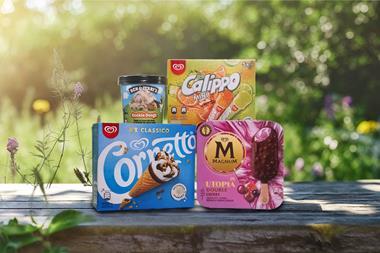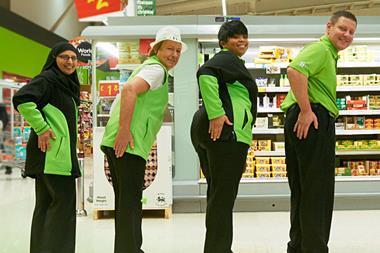Growth in fruit juices and fruit drinks has been polarised at each end of the market. Sunny Delight has been injecting heady growth into juice drinks while, at the other end of the price spectrum, chilled not-from-concentrate fruit juice is outperforming the rest of the fruit juice sector.
The combined fruit juices and juice drinks market was worth £550m and grew 9% in the year to December '99 [Taylor Nelson Sofres Superpanel].
Growth has come mainly from juice drinks up 30% in the period, almost wholly due to Sunny Delight.
Tropicana from the US entered the UK in 1991 and developed the not-from-concentrate chilled fruit juice sector, now at £119m.
The chilled not-from-concentrate market increased 28.8% in value in 1999 with Tropicana up 23.8%, own label up 34% and the overall chilled market increasing 12.7% [AC Nielsen].
Not-from-concentrate accounted for 51.4% of chilled in value good going when you consider the market did not exist until 1991.
David Biggs, Tropicana's category management controller for Europe, says: "Now, not-from-concentrate continues to be the driver for the chilled fruit juices sector. Consumers were looking for better tasting juices and the health benefits."
Richard Hall, chairman of Zenith International soft drinks consultancy, adds: "Tropicana created and pioneered the chilled not-from-concentrate sector in the early years and explained it to consumers.
"The last two years have seen individual product successes through brands' and supermarkets' work in upgrading presentation and packaging.
"In the overall market there is growth at both the cheap and expensive ends.
"The whole sector in the UK is one of the largest in Europe and one of the most sophisticated, with efficient retail distribution for fresh product and many flavours, types of packaging and price points."
While not so long ago the only place you could get a decent choice of fruit juices might have been your local pub, now there is an astonishing variety at retail level.
Gerber Foods' Ocean Spray was the second biggest brand after Sunny Delight in the combined ambient fruit juices and juice drinks market in 1999 and ended the '90s with 52% year on year value growth [TN Sofres].
Marketing director Rob Spencer says: "It offers a combination of unique fruit/dry adult taste and refreshment coupled with substantiated health benefits. It's more than a drink, it offers a genuine feelgood' factor."
Austria's Pago Fruit Juices was launched in the UK at the end of 1998 and now has a turnover of £1m.
With so much activity and innovation at the two extremes of the market it is the more mature, large volume, ambient middle market that has been suffering in the growth stakes. But it continues to offer an economic choice for consumers, especially those, such as families, who require large quantities of pure juice.
The role of multiples in offering discounted multipacks has been important here.
During the last year, sales of ambient pure juice amounted to 480 million litres and chilled pure juice reached 150 million litres, so ambient pure juice remains a key volume category.
But it is easy to understand manufacturers' interest in the chilled sector since the margins are far higher.
About 80% of the ambient market is own label and the multiples, particularly in their plain pack economy ranges, offer extremely keen pricing. This part of the sector inevitably has a commodity image and the brands have had to position themselves as a quality alternative to build customer loyalty.
One of the leading brands, Del Monte had a 10.3% volume and 14.4% value share at the end of February [AC Nielsen]. Del Monte's Just Juice brand, acquired in March last year, competes in the independents alongside other small format boxed drinks.
While the Del Monte brand is itself, for example, guaranteed 100% Brazilian orange juice and adult and family targeted, Just Juice has a younger customer profile and is sourced from various countries.
Angela Ellis, UK marketing manager says that in terms of product it can be difficult to differentiate pure juices, but fruit aromas used through natural technologies have been successful in building loyalty, providing an individual taste consumers can identify with.
Del Monte is monitoring the functional market closely. In the past it has tried a vitamin enriched product and Ellis points out that, for some consumers, additives can detract from the product purity.
Cranberry is proving popular for Just Juice driven by health considerations and Ellis says that there are possibilities for the Del Monte brand itself.
Ellis says research shows only 11% of consumers have juice at breakfast and as the five portions of fruit and vegetables per day recommended by health campaigns can sound daunting, the easy option of juice to start the day offers a market for development.
Last year Del Monte launched acampaign The Fruity Way Towards Five-A-Day' with this single theme running through all communications.
While ambient is showing little gain, with zero volume growth projected for 2000 by Taylor Nelson Sofres Superpanel, sectors like cranberry are performing strongly.
Princes has 26% of the ambient independent market, compared with 19.6% in the previous year, and is the fastest growing brand in that market [TN Sofres Superpanel]. It also produces own label for most of the multiples.
Marketing controller Steve McElhatton says: "Demographic change in the UK population is playing an important role with a greater number of people over 35 now, and they are increasingly health conscious."
He emphasises that many consumers switch between different sectors. "They may consume ambient in the morning, then at weekends chilled comes more into its own.
"There is also great segmentation of the market. For instance, kids tend not to like fruit bits, while many adults do," he says.
McElhatton describes cranberry as the "phenomenon of the decade". Princes has benefited with its Princes Finest cranberry range.
"The unique taste of cranberry is particularly appealing to older, adult consumers, attracted by its health properties," he says.
On pack offers such as a cocktail shaker have been driving cranberry sales. Research has shown that cranberry's third most popular use is as a cocktail mixer, especially among the young and affluent.
{{FOCUS SPECIALS }}
Close menu
- Home
- Retail & Wholesale
-
Products & Suppliers
- Back to parent navigation item
- Products & Suppliers
-
Product Categories:
- Back to parent navigation item
- Product Categories:
- Alcoholic drinks
- Bakery
- Cereals & breakfast
- Cheese
- Chicken & poultry
- Chocolate
- Confectionery
- Crisps, nuts & snacks
- Dairy
- Fish
- Fresh produce
- Frozen
- Household
- Meat
- Own Label
- Sauces & condiments
- Seasonal
- Soft drinks
- Vaping
- Vegan & plant-based
- World foods
- Suppliers
- People
- Reports & Data
-
Topics A-Z
- Back to parent navigation item
- Topics A-Z
-
Popular topics:
- Back to parent navigation item
- Popular topics:
- Cost of living crisis
- Crime
- Deposit Return Schemes
- Finance
- Government & Regulation
- Health
- Inflation
- Loyalty
- Marketing
- Mergers & Acquisitions
- New Product Development
- Sourcing
- Supply chain
- Sustainability & environment
- Technology
- Ultra Processed Foods
- Vaping
- A-Z all topics
- Content by type:
- Events
- Ask iA (beta)
- Subscribe now
Sign in to comment on this article
Not logged in before? Register for FREE guest access today.
You will be able to:
- Read more stories
- Receive daily newsletters
- Comment on stories
Advert
















No comments yet